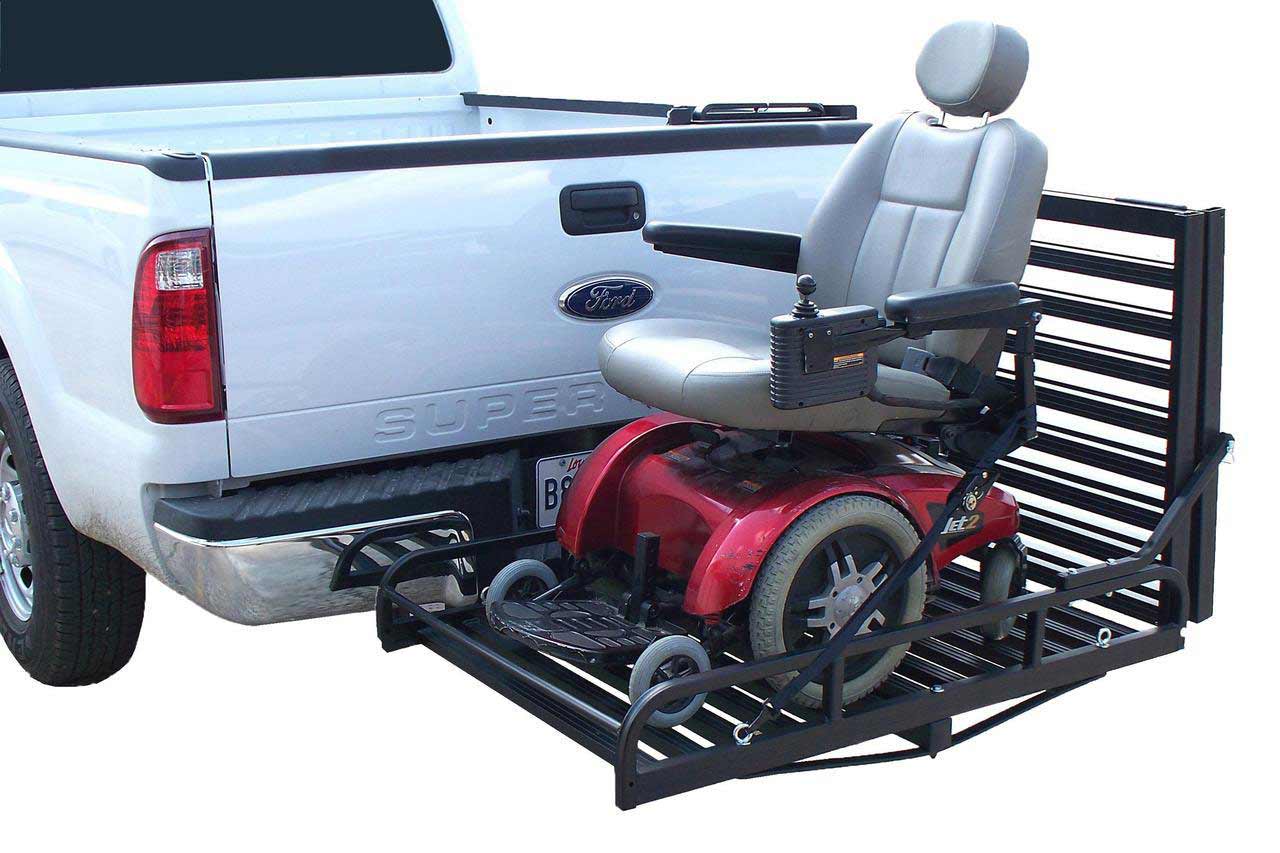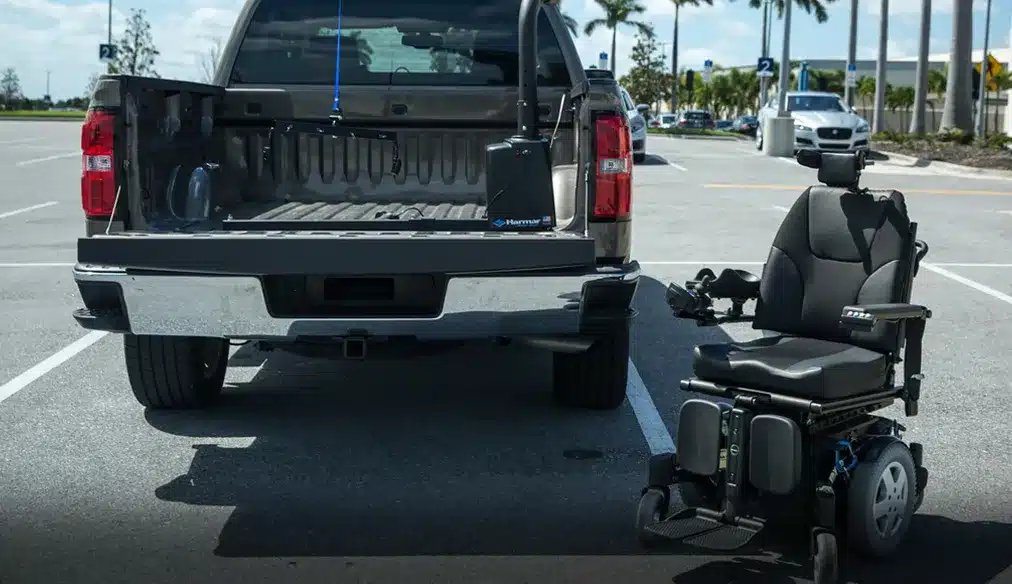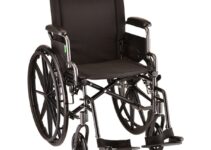Are you looking for the perfect way to transport your wheelchair? If so, you’ve come to the right place!
Here, we’ll provide all the necessary information about using a wheelchair carrier for your vehicle. With our tips, transporting your wheelchair will be a breeze. Get ready for safe and easy transportation!

A disabled man has gotten out of a car, and is sitting in his wheelchair. His loving wife is standing beside, with her arm around him. They are smiling at the camera.
Having a wheelchair carrier for your vehicle is a great way to make traveling more accessible for those with mobility limitations. Whether you’re planning an adventure or just need to get from place to place, having a carrier can make transportation easier and safer.
This guide will cover the basics of choosing and using a wheelchair carrier, as well as some safety considerations. Before you purchase or install a carrier, it’s important to understand the different types available and how they work. Keep reading to learn everything you need to know about making your car more accessible with a wheelchair carrier!
Explanation of wheelchair carriers for vehicles
Wheelchair carriers for vehicles are transport devices specially designed to safely and conveniently transport wheelchairs outside of a vehicle. They consist of a ramp or lift system that places the wheelchair safely in the vehicle and seats that may be used by both those using the wheelchair and able-bodied persons. Some wheelchair carriers also come with side-facing seats on either end of the lifted platform, providing additional seating space.
To ensure safe operation, wheelchair carriers must meet certain Department of Transportation requirements before they can be used in any public areas or highways. The carrier must be equipped with safety belts, as well as hold down devices, safety doors, and testing systems that demonstrate functionality. Many models also include electronic controls for added safety. Additionally, some states require extra regulatory measures depending on the size and weight capacity of the vehicle’s load-bearing capacity.
To understand how to properly use your vehicle’s wheelchair carrier system, it is important to become familiar with its features and operating instructions prior to any loading or unloading of your wheelchair onto/off of your vehicle. The following sections will provide greater details about how to use your vehicle’s wheelchair lift/carrier systems effectively and safely so you can enjoy all your travels in comfort.*
Importance of using a wheelchair carrier
When you are using a wheelchair, it is essential to consider the transportation needs of the user. A wheelchair carrier is an efficient way of transporting a wheelchair and can come in handy in many situations. There are many benefits to using a wheelchair carrier for your vehicle, such as:
-Safe transport of wheelchairs: The design elements of the carriers ensure that wheelchairs are safely loaded and transported to their destination. This prevents damage during transportation or unnecessary accidents due to loose wheelchairs.
-Hassle-free transportation: Transportation of wheelchairs with a carrier means less risk for you and your loved one in case of emergency situations. You can quickly and safely drive with your wheelchair loaded for any sudden requirements.
-Easy storage: Wheelchair carriers also help with storage solutions since they have larger loading areas than traditional vehicles used to travel with wheelchairs alone. This means that you can store your equipment appropriately and easily when not needed.
-Cost effective: The use of a wheelchair carrier significantly reduces costs associated with travelling, as they eliminate the need for additional vehicles whenever necessary.
Selecting a Wheelchair Carrier
When selecting a wheelchair carrier for your vehicle, there are several things to consider. First, do some research to determine the size, weight and other specifications of your wheelchair. This will help you narrow down the options for selecting a suitable carrier to fit your needs. Next, make sure you have enough space on your vehicle’s roof or back hatch to accommodate a carrier — if this is not possible, there is also the option of finding a good hitch adapter that allows you to install carriers on the back of a vehicle.
The type of wheelchair carrier will also depend on how secure it needs to be when transporting your wheelchair. There are several types of carriers available including Hitch-Mounted models and Platform Lift-style models — each has advantages and disadvantages that need to be taken into consideration when choosing which one is best for you. Platform Lift-style carriers are able to support heavier wheelchairs or scooters while still providing easy accessibility and storage room within the vehicle when not in use — however they tend to be more expensive than other styles.
The safety features offered on a Wheelchair Carrier should not be overlooked either as they can make all the difference in transporting your wheelchair safely and securely. Many Wheelchair Carriers offer tie down straps and/or anchor systems with adjustable receivers — these features allow you to secure any item being transported with hooking devices or straps designed specifically for wheelchairs or mobility equipment. Additionally, other features such as those allowing quick detaching may become essential depending on what type of disability accessibility is required. Make sure that whatever Wheelchair Carrier selected fits well onto your vehicle as well as fitting around any ramps being used by providing plenty of clearance for doorways or driveways without risking occupancy safety hazards due getting lodged in tight spaces!
A.Choosing the appropriate carrier for your wheelchair
Choosing the right wheelchair carrier for your vehicle will depend on the type of wheelchair you use and its size. Before buying a carrier, you need to measure the dimensions of your wheelchair including its height, width, and length. Note that some carriers may have weight limits, so it’s important to make sure that your wheelchair or powerchair is comfortably within these limits. You’ll also want to make sure that your chosen carrier can be easily mounted onto your vehicle for easy loading and unloading.

It’s important to consider all these factors before buying a wheelchair carrier for your vehicle. Make sure you read through all product details in order to ensure that you select a model that meets all of your needs and fits within all safety guidelines. It might also be helpful to check customer reviews in order to get an idea of what other people think about the product you are interested in purchasing.
Compatibility with your vehicle
Choosing a Wheelchair Carrier with the right design and fit is critical to ensure that it is compatible with your vehicle. Before buying a wheelchair carrier, make sure to research the model so you know what size and weight specifications your vehicle manufacturers recommend.
Wheelchair carriers come in different sizes, shapes, and designs. Each serves its own purpose, such as transporting manual wheelchairs, power wheelchairs, scooters, or stretchers safely and conveniently. To ensure compatibility with your vehicle’s hitch receiver and other components, read the product specifications carefully before making a purchase.
In addition to researching the manufacturer’s recommendations for size and weight requirements for your vehicle’s hitch receiver, be sure to measure the dimensions of your hitch receiver opening before selecting a Wheelchair Carrier. If you are unsure if a certain model will be compatible with your car or truck’s hitch receiver opening size, always contact the manufacturer directly for more information before making a purchase decision.
III. Preparing for Use
If you have chosen to use a wheelchair carrier to transport your wheelchair, there are some steps you will need to take in order to prepare the carrier before use. The following steps will help ensure that your wheelchair is safe and secure while it is on the carrier:
- Check all parts of the carrier, including locks and hooks, for any signs of wear or damage. Any damaged parts should be replaced before attempting to use the carrier.
- Read the manufacturer’s instructions carefully and make sure you understand how to operate the wheelchair transporter safely and securely.
- Place your wheelchair on or in the rack or basket on top of the carrier, making sure it is securely attached using straps, locks or ropes as required by your manufacturer’s recommendations.
- Securely fasten all tie-down straps according to recommended guidelines from your manufacturer’s instructions, if provided with them when purchasing your transporter system. Make sure that all of these straps pass through attachment points on both ends and are pulled tightly so that they cannot come loose during transit.
- Test all locking mechanisms after securing the wheelchair support device onto your vehicle prior to transporting it away from home or traveling across town with it on board your vehicle.
Reading the instructions
Before attempting to use a wheelchair carrier, it is important to carefully read the user manual to familiarize yourself with the device and its components. Driving with a wheelchair securely mounted on your vehicle requires knowing the proper usage of your equipment.
Depending on the wheelchair carrier, there may be several components that need to be adjusted or installed prior to use. Failing to correctly install or adjust a wheelchair carrier can lead to an increased risk of injury or harm. All necessary installation instructions should be followed closely and all parts should be tightened securely so they will not become loose while in transit.
In addition, it’s important that all straps, buckles and other restraints are used as instructed in order to safely secure the wheelchair taking into account its weight and size. The user manual should also provide instructions for proper maintenance as well as when service or repairs are needed for the equipment.
Familiarizing yourself with the carrier
Before using your wheelchair carrier, it is important to familiarize yourself with how it works. Many carriers require the use of a hitch that can be mounted onto a vehicle or trailer. Hitch types vary based on the model of carrier you have and the type of vehicle you are attaching it to, so be sure to check with your manufacturer or retailer for their specific instructions.

After the hitch is installed correctly, review general safety instructions for your wheelchair carrier such as proper placement and loading, securement straps or locks that may come with the carrier and any needed periodic maintenance. Additionally, make sure that you know where wheel-locks, brakes and lights are located so that you can easily find them in order to secure the chair onto your vehicle before every trip.
Conclusion
No matter what type of wheelchair carrier you choose, it’s important that you take the time to find one that is best for your needs. It should be safe, secure and easy to use. Do your research and assess what options are available in terms of size, weight, safety features and convenience.
Wheelchair carriers can provide a safe and convenient way for those with mobility limitations to get about their daily lives. With some time and research you can find a wheelchair carrier that fits both your needs and vehicle size. Once installed, it will provide peace of mind when transporting a wheelchair or other mobility aid safely wherever life takes you.
FAQs
How do you carry a wheelchair in a car?
There are different ways to carry a wheelchair in a car, such as using a car lift or ramp, folding and storing the wheelchair in the trunk, or using a wheelchair carrier attached to the back of the car.
What are some tips and tricks for wheelchair users?
Some tips and tricks for wheelchair users include learning to navigate different terrains, using proper posture and positioning, maintaining and repairing the wheelchair, and seeking out resources and support networks.
How do you use a transport wheelchair?
To use a transport wheelchair, one must first unlock the brakes, assist the person into the chair, fasten the seatbelt, and then push or pull the chair to the desired location.
Where do you put a wheelchair in a car?
The location where a wheelchair is placed in a car depends on the type of car and the method of transportation. Options include the trunk, back seat, or attached carrier.
What is the best way to transport a wheelchair?
The best way to transport a wheelchair depends on the situation and the type of wheelchair. Options include using a car lift or ramp, folding and storing the wheelchair in the trunk, or using a wheelchair carrier attached to the back of the car.
How do you secure a wheelchair in transport?
To secure a wheelchair in transport, one can use tie-down straps or clamps attached to the wheelchair and anchor points in the vehicle, ensuring that the wheelchair is stable and cannot move during transit.
What is basic wheelchair etiquette?
Basic wheelchair etiquette includes respecting the personal space and independence of the wheelchair user, avoiding touching or moving the wheelchair without permission, and being mindful of physical barriers and obstacles.
What is good wheelchair etiquette?
Good wheelchair etiquette includes treating wheelchair users with respect and dignity, offering assistance when needed but not assuming help is necessary, and advocating for accessibility and inclusivity.
What is the most difficult thing for wheelchair users?
The most difficult thing for wheelchair users can vary depending on the individual, but common challenges include accessibility barriers, social isolation, discrimination, and physical discomfort or pain.
How can I improve my wheelchair accessibility?
Improving wheelchair accessibility can involve advocating for accessibility and inclusion in public spaces and transportation, investing in accessible technology and equipment, and supporting organizations and initiatives that promote disability rights and accessibility.
See Also-
- Best walker wheelchair combo 2023
- Best transport wheelchair 2023
- Best reclining wheelchair 2023
- Best lightweight electric wheelchair 2023
- Best all terrain wheelchair 2023

